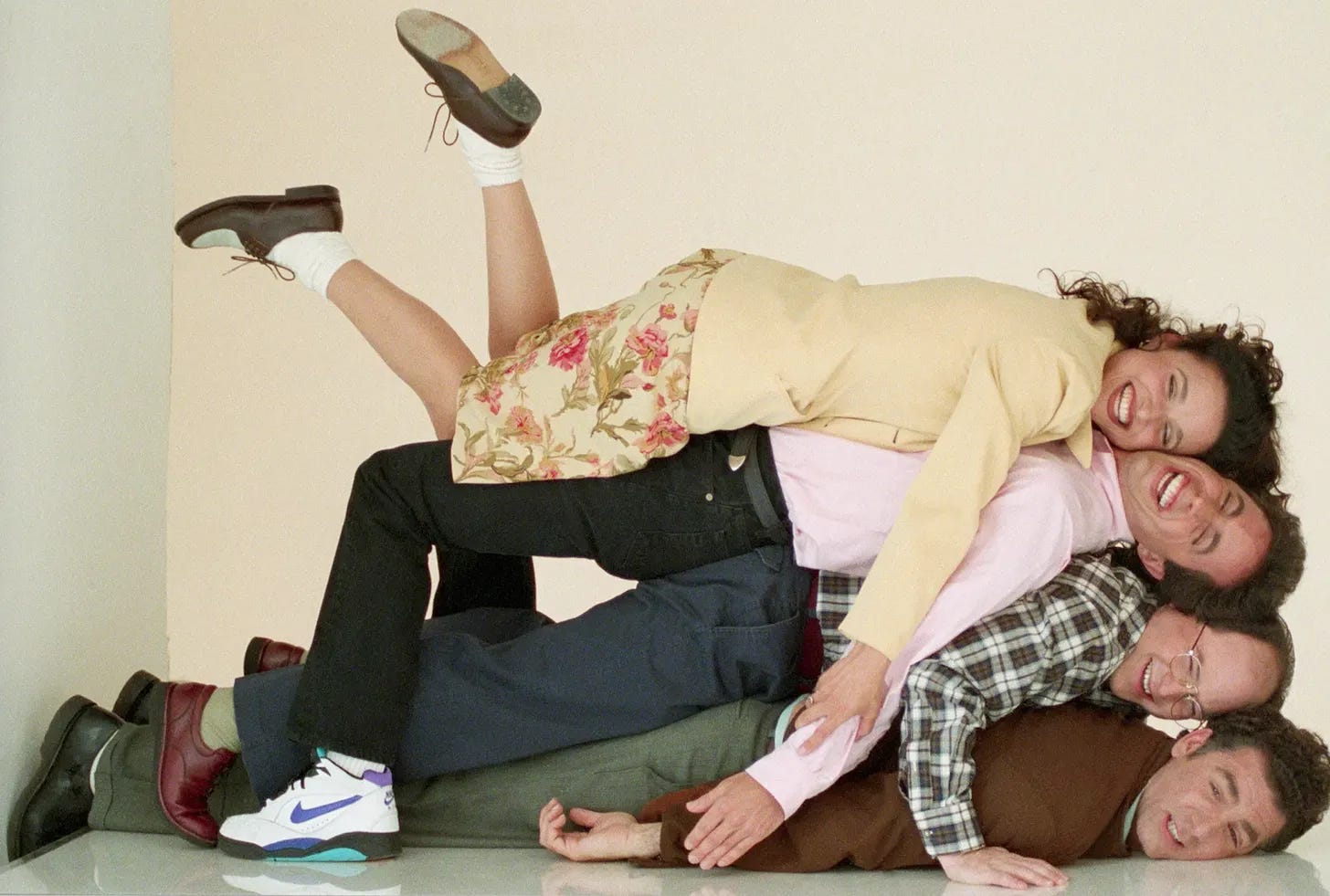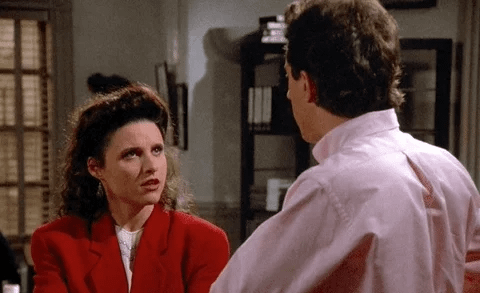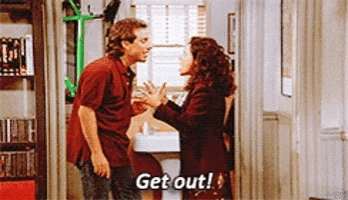The Semi-Egalitarian Sex Life of Elaine Benes
Looking back, Elaine’s sexual freedom was one of the best things about Seinfeld.
With all its glorious New York-isms and irreverent take on all things ordinary, Seinfeld was my nightly comfort viewing for years and years—there are few episodes I can't recite by heart. The appeal had absolutely nothing to do with Jerry, little more to do with the ridiculous antics of Kramer and George, and everything to do with Elaine, the sole source of estrogen in the mix (as given a pulse by the brilliant Julia Louis-Dreyfus). As a one-of-the-guys kind of girl with a nascent writing career (right down to the clothing brand copywriting gig), there was something of a vibe parallel between my life and Elaine’s life that I rarely saw elsewhere, every eye-roll of hers echoing a disparate moment of my own ‘90s experience.
I spent much of that decade trying to navigate the indie music biz, which was largely a boys’ club. Never having linked my intrinsic value to my feminine wiles, I moved through that world developing many platonic friendships with fellow music nerds, most often dudes, and I cherish our affinity to this day. But as a rare alto-soprano in their Greek chorus, I found it oddly enlightening and empowering to bear witness to the workings of their frontal lobes and resulting ins and outs of their romantic relationships—intel that made me cynical and picky when choosing candidates for my own. Gender was rarely a consideration in forming friendships for me; so often a “hag” in circles of gay men, humor was how I liked to connect with people. But when you’re one of the straight guys you know too much and, at that time, knowing too much about the internalized misogyny of young men made it incredibly challenging to romanticize what it might be like to date them. Perhaps this is why Elaine never took dating seriously either—she, also, knew too much.
On the topic of internalized misogyny, Jerry Seinfeld recently told Bari Weiss he was nostalgic for the era of “dominant masculinity” so it’s no surprise the guys on Seinfeld always, miraculously, got laid. Naturally, Jerry took the liberty to portray himself as a lothario (though that never, ever made sense to me), Kramer as a “hipster doofus” who trips into sex, and George as the detestably awkward “slow-witted” man who somehow managed to attract smart, beautiful women like Marisa Tomei. As myopic in purview as any TV show in the early 90s for blinding whiteness or for relegating women to plot tropes like the over-it girlfriend-or-wife of (see King of Queens) or object of romantic obsession and/or unconsummated sexual tension (Friends), it’s still somewhat surprising to me the character of Elaine also got to date or have sex with whoever, whenever.
As a one-of-the-guys kind of girl with a nascent writing career (right down to the clothing brand copywriting gig), there was something of a vibe parallel between my life and Elaine’s life that I rarely saw elsewhere, every eye-roll of hers echoing a disparate moment of my own ‘90s experience.
The fact that Elaine was written into Seinfeld to lend a “female voice” (whatever that means) as Jerry’s ex-girlfriend was almost immediately classified as an afterthought and she was free to explore her sexuality just as the guys did, but it did take a season or two for Jerry and Larry David to let her get there. First, they had to figure out how to resolve any sexual tension between them and find a pedantic solution. In season two, Jerry and Elaine are innocently watching TV when they happen upon some porn, he gives her “that look,” which results in a rekindling of the physical aspect of their romance with no strings—an arrangement she unwittingly proposes before realizing it is designed to appeal to only him. In contrast to how Elaine is portrayed in every subsequent season, sex with Jerry gives her amnesia about how much of a dog he is, until she realizes he couldn’t possibly want “this, that, and the other” out of their relationship the way she does.
As the seasons go on, it becomes increasingly hard to imagine her and Jerry ever together: Jerry’s conveyor belt of conquests are largely one-dimensional prototypes of male-projected femininity as comic foil where Elaine is permitted to flourish into the designated three-dimensional everywoman, vacillating wildly between object of desire and irreverent buffoon while her guy friends remain steadfast idiots. In contrast to Samantha Jones, whose sexual proclivities were amped up almost performatively on Sex And The City, Elaine Benes was a straight cis everywoman out in the world, matter-of-factly getting her needs met and “yada yada yada-ing” sex without much pomp and circumstance. She always entered into relationships with one foot out the door, constantly tasked with dismantling some myth about what it meant to be a woman in situations that would never fly today.
Her misadventures are as cartoon-like as theirs: She attempts to convert a gay man for “the sex and the shopping”; she attempts standards by interviewing one boyfriend (who would later be Luke on Gilmore Girls) to make sure he’s "sponge-worthy"; she develops a phone crush on a video store worker because of his video picks before showing up at his mom’s with vodka and cigarettes and finding out he is 15. In “The Contest,” her friends insist their primal urge to masturbate outpaces hers: “It’s what we were born to do,” argues Jerry. “It’s part of our lifestyle.” When she finally gives in to self-pleasure after hunky John F. Kennedy, Jr. makes a date with her, she loses the bet and has to fork over a sawbuck (she could only get in on the bet 2-to-1) to George and Jerry, much to George’s surprise. “I expected you to cruise, at least through Spring,” he says, once again confirming his complete ignorance about women and leaving her to clear things up.
Oddly enough, it doesn’t even occur to either George or Kramer to be attracted to her until she leaves a mysterious saucy message on Jerry’s tape recorder as a joke. This same level of ignorance was echoed by one equally misogynistic male culture writer, who spent one reductive, frustrating Vox article trying to figure out if Elaine the character was meant to be “hot” according to how the men around her responded to her. After all, according to him, when you’re an attractive woman and one of the guys in the 90s, the ultimate validation lies in someone wanting to fuck you.
As myopic in purview as any TV show in the early 90s for blinding whiteness or for relegating women to plot tropes like the over-it girlfriend-or-wife of (see King of Queens) or object of romantic obsession and/or unconsummated sexual tension (Friends), it’s still somewhat surprising to me the character of Elaine also got to date or have sex with whoever, whenever.
The thing is, at her core, Elaine didn’t give a shit what anyone—especially men—thought of her. The “queen of confrontation” wasn’t afraid to shove her friends, throw hands with George’s father, or throw George’s toupée out the window if she didn’t like it. Eventually, the power balance with Jerry is restored in “The Mango,” when Elaine tells Jerry she was faking orgasm the whole time they were together. With Jerry at the helm, this can only result in their having sex to save the friendship, but she sees it as a perfunctory task (“I’ll give you half an hour”) and he can’t get it up. In so many other episodes, she refers to her former relationship with Jerry as something she can barely believe she bothered with herself.
There are a few episodes in which Elaine seems to gather the sense to move on from these morons, weary of the awkward, annoying vibe of being the only girl in the room. In “The Little Jerry,” Elaine finds herself at a late-night cockfight in a bodega basement, leading her to consider a recent marriage proposal from someone she could give three shits about with this memorable line: “Jerry, it's three-thirty in the morning. I'm at a cockfight. What am I clinging to?" In “The Bizarro Jerry,” Elaine trades up to the company of three revisionist, ethical versions of her friends until she shoves one of them and they realize she’s too flawed to hang with them.
Louis-Dreyfus looks back on playing Elaine as fun. “I don’t play good girls,” Louis-Dreyfus recently told New York Times Magazine reporter Lulu Garcia-Navarro last month. “I don’t play girls who behave a way that a good girl should behave. If they do, they do it with bitterness and anxiety. I’ve played a lot of characters who push back on the position that they’re in, who are not content with their place in the world. And that’s real.” When asked if Seinfeld would get made now, Louis-Dreyfus coyly admits much of the show took risks that didn’t age well. “When Seinfeld was made, it was really unlike anything that was on at the time. It was just a bunch of losers hanging out. So I would say one main reason it wouldn’t be made now is because it’s hard to get anything different recognized. Particularly nowadays, everyone’s sort of running scared.”
I don’t know that it’s running scared so much as how cultural evolution led to an evolved perspective on the show. My friend, the writer Jennifer Barnett, recently dedicated a whole post to hating Jerry Seinfeld in her Substack, Stroopwaffled. “He’s selfish and dismissive and steeped in money, power, and influence in ways that are emblematic of much of what’s wrong with America right now,” she wrote, citing his icky, patriarchal attitudes toward female guests, his wife, and his kids as examples. I understood how she felt. In 2020, I published a rebuttal op-ed in The New York Daily News to Jerry's New York Times pandemic rah-rah op-ed about New York City not being dead—the one he penned from his cushy Hamptons lair while people like me were squished four to 1000 square feet, wearing masks to Key Food for months on end. I don't know if he read it, but soon after a televised interviewer asked him what he'd say to people who called him out on the fact that he wrote that op-ed from the Hamptons while they were stuck in the city to which he dismissively replied, "Sorry I did better than you."
As the seasons go on, it becomes increasingly hard to imagine her and Jerry ever together: Jerry’s conveyor belt of conquests are largely one-dimensional prototypes of male-projected femininity as comic foil where Elaine is permitted to flourish into the designated three-dimensional everywoman, vacillating wildly between object of desire and irreverent buffoon while her guy friends remain steadfast idiots.
The Seinfeld of it all aside, my attitude toward my lot as one of the guys has also evolved with the times into something far less dick-tated (see what I did there?) by the patriarchal. As a long-married cis person who believes in the dissolution of binary hierarchies I realize, on some level, I’ve always known how platonic friendships between those who identify as men and women thrive most on a fluid spectrum. When you take sex off the table, we can all relate to each other through shared humor, experiences, and mutual understanding, gender constructs be damned. Isn’t that nice?
As a Gen Xer, when it comes to art and artists, I’ve become accustomed to holding two truths. So many films and TV shows have required us to cherish the bits and bobs that resonated with us and relegate the glaring misogynistic and homophobic misfires to the incredibly flawed Reagan-Bush hangover of the time. But I know this: Every time I see Elaine Benes freely and guilelessly embody her ID by yelling “Get out!” and shoving one of her friends to the ground, I see it as one of the things Seinfeld got right.









I am with you in every sentence. every word. I worshipped Elaine. Loved this line: "She always entered into relationships with one foot out the door, constantly tasked with dismantling some myth about what it meant to be a woman" - YESSSSS
I rewatched Seinfeld during lockdown and appreciated Elaine far more than I did first time around. The sponge-worthy episode really made me laugh. This is a wonderful write up of her.